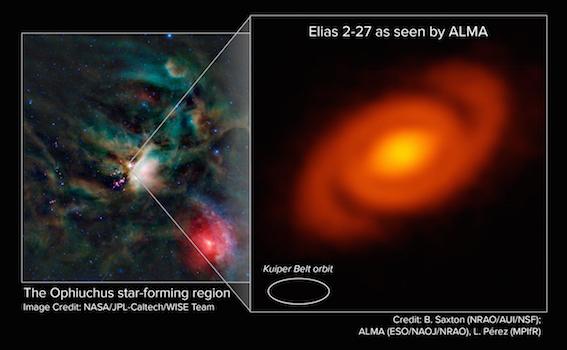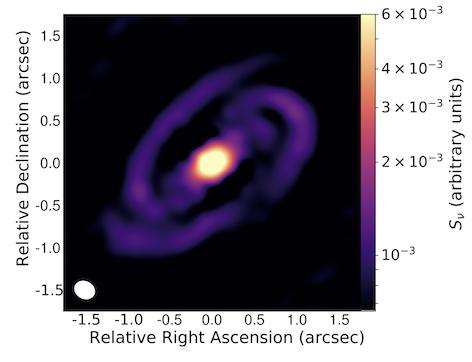Observing the earliest stages of star and planet formation
Spiral waves detected in a disc around a very young star may be indicative of a gravitational instability.

There was a recent ALMA observation (Perez et al. 2016) of a very young stellar system (Elias 2-27) in which there appeared to be a two-armed spiral-like structure present in its circumstellar disc (top figure on the right). This is particularly interesting because the discs around these very young stars can be quite massive and these spiral waves may be a consequence of a gravitational instability. This has never before been directly observed in such systems.
To test this possibility, we ran a suite of numerical simulations with properties comparable to that of the Elias 2-27 system and that were susceptible to the growth of a gravitational instability. We then post-processed these simulation results with a radiative transfer code and fed the resulting emission maps through the ALMA simulator to determine what would actually be observed.
The lower figure on the right shows the results from one of our simulations and indeed indicates that the two-armed spiral could be due to a gravitational instability. However, the range of parameter space over which an observable two-armed spiral does emerge is actually quite small; many of our simulations did not produce such observations.
On the other hand, it is known that these spirals waves may act to locally enhance the concentration of solid particles. The emission that we are observing is actually coming from small dust grains. When we included this dust enhancement in our simulations, we did find that this increased the range of parameter space over which such spirals might be observed.

However, the range of parameter space over which such spirals could be observed is still quite narrow and may suggest an alternative origin. At this stage it is not really possible to make any strong claims as to whether the spirals observed in the disc around Elias 2-27 are due to a gravitational instability, or have another origin. It is, however, still fascinating that we can make observations of such very young systems. The origin of such spirals will probably become clearer as we make more and more observations of very young protostellar systems.
Links:
Is the spiral morphology of the Elias 2-27 circumstellar disc due to gravitational instability?
Spiral density waves in a young protoplanetary disk.

